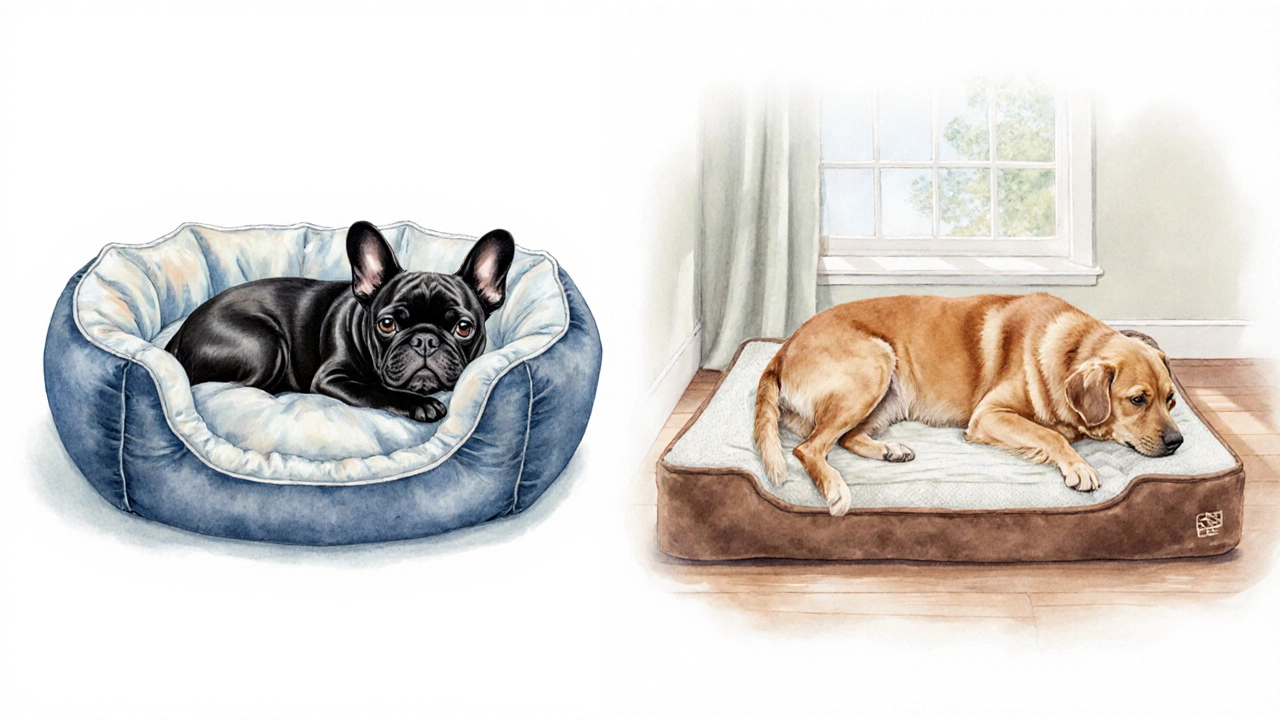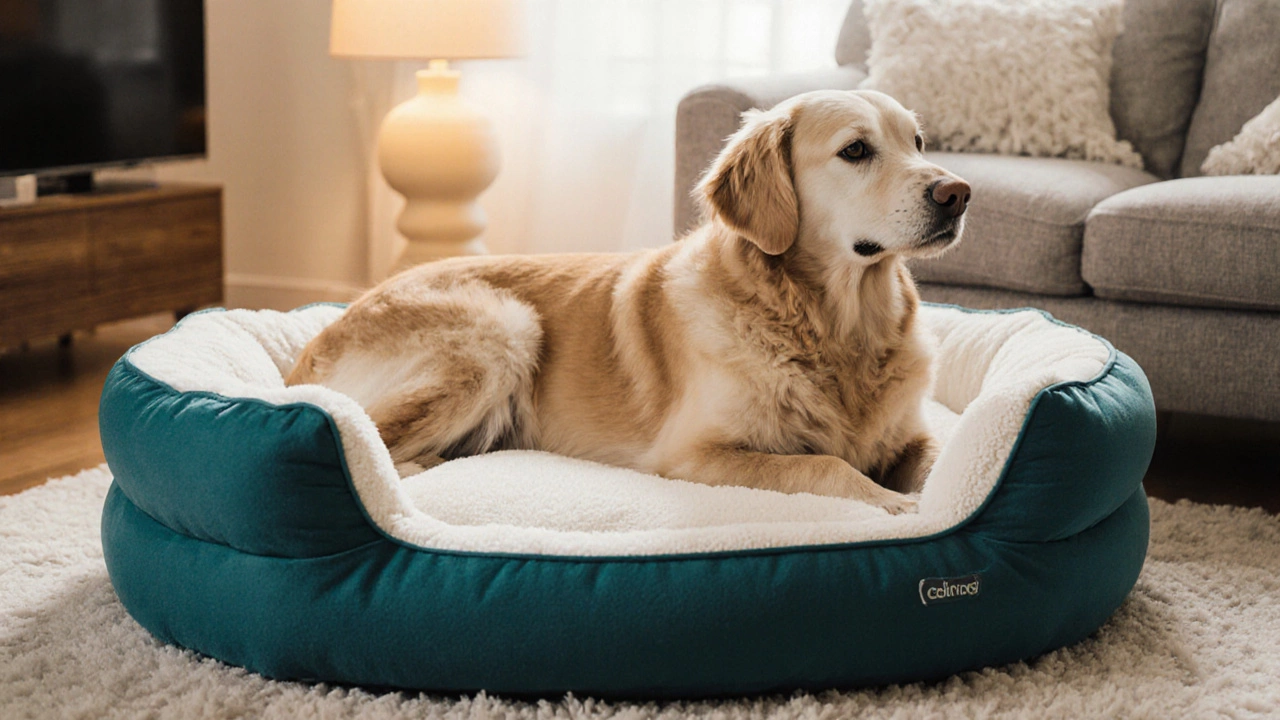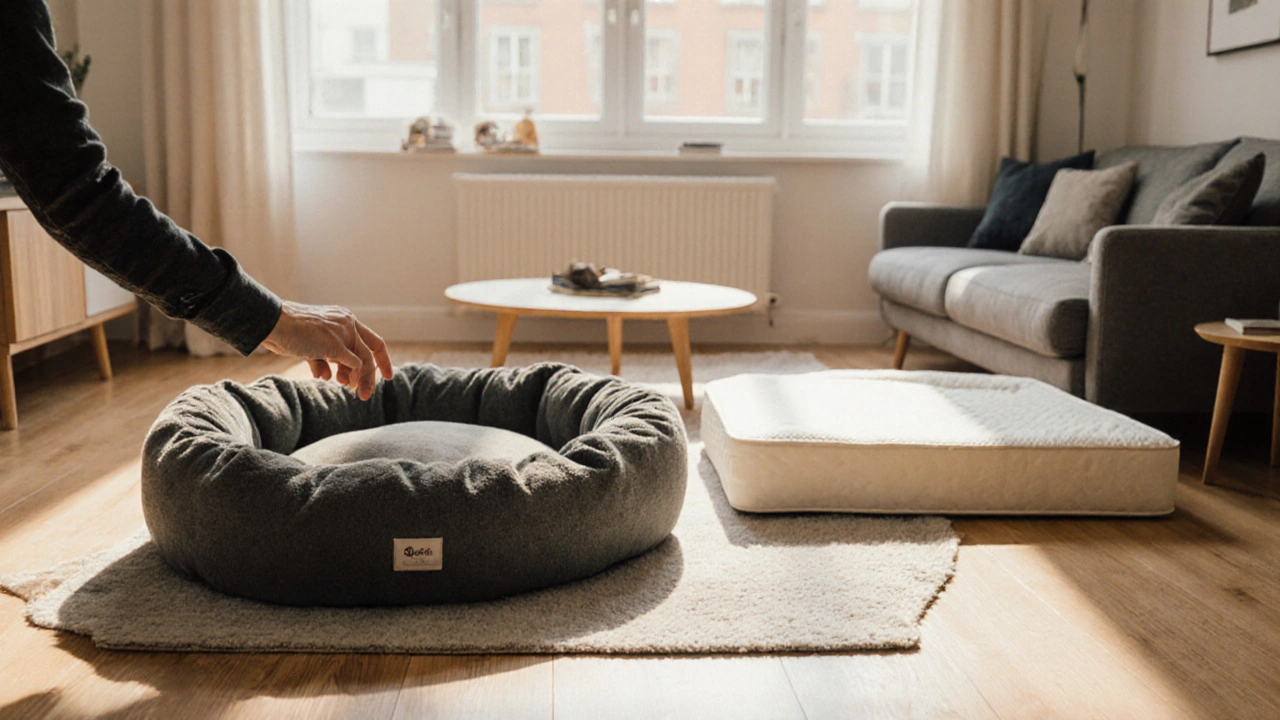Dog Bed Shape Selector
Recommended Bed Shape
Round Bed
Perfect for curling dogs
Ideal for small to medium dogs that like to curl up.
Rectangular Bed
Great for stretching dogs
Best for large, active breeds that stretch out.
Recommendation Details
Shape Comparison Table
| Attribute | Round Bed | Rectangular Bed |
|---|---|---|
| Space for movement | Limited; encourages curling | Ample; supports stretching |
| Fits corners | Excellent; circles into angles | Moderate; may need extra space |
| Ideal for which breeds | Small-to-medium, curl-preferencing | Large, active, side-lying |
| Support level | Even pressure around center | Linear support; good for long backs |
| Typical size options | 12-24 in diameter | 24-48 in length |
| Price range (USD) | $30-$120 | $40-$150 |
Ever wondered if the shape of a dog beds actually matters? Most owners pick a bed based on looks or price, but a dog’s comfort, safety, and sleep quality can hinge on whether the bed is round or rectangular. This article breaks down the science, breed quirks, and practical tips so you can choose the right shape for your four‑legged friend.
Quick Takeaways
- Round beds work best for small‑to‑medium dogs that like to curl up.
- Rectangular beds suit large, active breeds that stretch out or need side support.
- Consider your dog’s preferred sleep position, joint health, and living space before buying.
- Orthopedic foam adds comfort for older dogs regardless of shape.
- Test the bed in the home environment; most retailers offer a 30‑day return.
What Is a Dog Bed?
Dog bed is a dedicated sleeping surface designed to support a dog’s joints, regulate temperature, and provide a sense of security. Modern dog beds range from simple fleece pads to high‑tech orthopedic memory foam models. The shape-most commonly round or rectangular-affects how a dog can position its body, how the bed fits into furniture, and how the material distributes weight.
Why Shape Matters: The Science of Canine Sleep
Dogs spend about 12‑14 hours a day sleeping. During deep sleep, their muscles relax and joints bear the full weight of the body. A bed that aligns with a dog’s natural posture reduces pressure points and can prevent long‑term joint issues.
Research from the University of Pennsylvania’s School of Veterinary Medicine (2023) showed that dogs that curled up on a supportive surface had a 15% lower incidence of hip dysplasia progression compared to those that slept stretched on thin mats.
Two key variables drive shape preference:
- Sleep position. Dogs typically sleep in one of three ways: curled (fetal), side‑lying, or stretched out.
- Body dimensions. Length‑to‑height ratio, weight distribution, and breed‑specific anatomy influence how much space a dog needs.
Round Dog Beds: Who Benefits Most?
Round bed is a circular sleeping platform that often features a raised edge or "nest" side. The edge mimics a den, giving dogs a sense of security.
Best for small to medium breeds that naturally curl, such as Chihuahuas, French Bulldogs, and Cocker Spaniels. The rounded shape cradles the body, distributing weight evenly around the center. This reduces pressure on the hips and elbows.
Round beds also fit neatly under coffee tables or in corner spaces where a rectangular bed would look bulky. For apartment dwellers, the compact footprint is a major win.
Potential drawbacks include limited length for dogs that like to stretch out. A long‑legged breed forced into a small circle may experience cramped joints.

Rectangular Dog Beds: Who Benefits Most?
Rectangular bed is a four‑sided platform that usually offers more linear space. This shape mirrors a couch or mattress, giving dogs room to lie flat or stretch.
Ideal for large, active breeds such as Labrador Retrievers, German Shepherds, and Great Danes. These dogs often adopt the side‑lying or fully stretched position, especially after exercise.
The straight edges allow the bed to slide under beds or sofas, making it easy to keep the sleeping area out of high‑traffic zones. Many rectangular beds also come with detachable sides for dogs that like to lean against a wall.
Potential drawbacks include a higher chance of the dog rolling off when it sleeps on its back, especially if the mattress is thin.
Key Attributes to Compare
| Attribute | Round Bed | Rectangular Bed |
|---|---|---|
| Space for movement | Limited; encourages curling | Ample; supports stretching |
| Fits corners | Excellent; circles into angles | Moderate; may need extra space |
| Ideal for which breeds | Small‑to‑medium, curl‑preferring | Large, active, side‑lying |
| Support level | Even pressure around center | Linear support; good for long backs |
| Typical size options | 12‑24in diameter | 24‑48in length |
| Price range (USD) | $30‑$120 | $40‑$150 |
How to Match Bed Shape to Your Dog’s Needs
Follow these steps to pick the right shape without guessing:
- Observe your dog’s typical sleep position for three nights. Does it curl up on a blanket or stretch out on the floor?
- Measure your dog’s length from nose to base of tail and height at the shoulders.
- Check your living space. Do you have a corner nook (good for round) or under‑furniture clearance (good for rectangular)?
- Consider joint health. Older dogs or breeds prone to hip dysplasia benefit from orthopedic foam regardless of shape.
- Factor in durability. Heavy chewers need a cover made from chewing‑resistant fabric and reinforced stitching.
After you’ve gathered this info, use the comparison chart above to decide which shape aligns best with the data.
Special Considerations
Orthopedic Support
Both round and rectangular beds can incorporate memory foam or high‑density orthopedic foam. For senior dogs, a 4‑inch thick foam layer can reduce joint pressure by up to 30% (Veterinary Orthopedic Journal, 2022).
Temperature Regulation
Dogs regulate body heat through the bed’s material. A breathable cooling gel layer works well in both shapes for summer months, while a removable fleece cover adds warmth in winter.
Size Adjustability
Some rectangular beds come with modular extensions that let you increase length as your puppy grows. Conversely, a round bed with a removable inner cushion can be downsized for smaller dogs.

Real‑World Examples
Case 1: Bella, a 12‑lb French Bulldog - Bella curled up on a plush round bed with a 16‑inch diameter. Within two weeks, her owner reported fewer nighttime “shifting” movements and a calmer sleep.
Case 2: Max, a 75‑lb Labrador Retriever - Max prefers a 36‑inch rectangular bed placed under the couch. The extra length lets him lie fully stretched after long hikes, and the firm foam reduces his occasional hip stiffness.
Both stories highlight that matching shape to breed size and sleep habit produces measurable comfort gains.
Tips for Testing a Bed at Home
- Place the empty bed on the floor for a night and watch where your dog settles.
- Use a temporary old towel as a “test liner” to avoid damaging a new mattress before purchasing.
- Check for any signs of anxiety-pacing, excessive licking of paws-when the dog first uses the bed.
- Rotate the bed’s orientation after a week; some dogs prefer the edge facing a wall.
When to Replace a Dog Bed
Even the best‑quality bed wears out. Look for these signs:
- Visible sagging in the foam core (more than 1inch depth loss).
- Persistent odor despite washing.
- Chewed or torn cover exposing foam.
- Your dog consistently avoids the bed.
If two or more of these appear, it’s time for a new bed. Most reputable brands offer a 30‑day comfort guarantee, so you can swap without risk.
Frequently Asked Questions
Do round beds help dogs with anxiety?
Yes. The enclosed edge of a round bed creates a den‑like environment that many anxious dogs find soothing. Pairing it with a familiar blanket amplifies the calming effect.
Can a large dog safely use a round bed?
Only if the round bed’s diameter exceeds the dog’s length plus a few inches. For most large breeds, a rectangular bed will provide more comfortable space.
What thickness of foam is best for senior dogs?
A 4‑inch high‑density orthopedic foam offers the best balance of support and pressure relief for aging joints.
Is it okay to wash a memory‑foam dog bed?
Most memory‑foam cores should not be submerged. Instead, remove the cover and machine‑wash it, then spot‑clean the foam with a mild detergent.
How do I know if my dog prefers a side‑lying position?
Watch your dog’s natural resting pose on the floor. If it often lies on its side with legs extended, a rectangular bed will likely be more comfortable.
